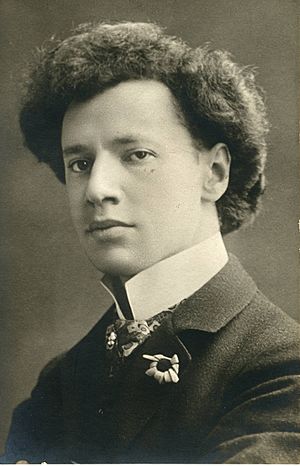Ossip Gabrilowitsch facts for kids
Quick facts for kids
Ossip Gabrilowitsch
|
|
|---|---|
 |
|
| Born | 7 February [O.S. 26 January] 1878 |
| Died | 14 September 1936 |
| Occupation | Pianist, conductor and composer |
| Spouse(s) | Clara Clemens |
| Signature | |
 |
|
Ossip Salomonovich Gabrilowitsch (born February 7, 1878 – died September 14, 1936) was a talented musician. He was a famous pianist, a conductor who led orchestras, and a composer who wrote music. He was born in Russia but later became an American citizen. He was also known for being married to Clara Clemens, the daughter of the famous writer Mark Twain.
Contents
His Life and Music
Early Life and Training
Ossip Gabrilowitsch was born in Saint Petersburg, Russia. His family was Jewish. From a young age, he showed great musical talent.
He studied piano and how to compose music at the Saint Petersburg Conservatory. This was a famous music school. Some of his teachers were very well-known musicians like Anton Rubinstein and Alexander Glazunov. After finishing his studies there in 1894, he went to Vienna. For two years, he learned even more about playing the piano from a famous teacher named Theodor Leschetizky.
Recording His Music
In July 1905, Ossip Gabrilowitsch was one of the first pianists to record his music. He recorded ten pieces for a special type of piano called the Welte-Mignon reproducing piano. This piano could play back exactly what a pianist played. Later, he made many more recordings for other reproducing pianos like Duo-Art and Ampico.
Family Life
On October 6, 1909, Ossip married Clara Clemens. She was a singer and the daughter of the famous American writer Mark Twain. Clara often performed with Ossip in concerts.
They had one child, a daughter named Nina. She was born on August 18, 1910, at Mark Twain's home in Connecticut. Nina was the last direct descendant of Mark Twain. She passed away in 1966.
Leading Orchestras
From 1910 to 1914, Ossip Gabrilowitsch worked as a conductor in Munich, Germany. He led an orchestra called the Munich Konzertverein, which is now known as the Munich Philharmonic.
When World War I started, he was arrested because he was from Russia, which was considered an enemy country. But with help from an important church official, he was set free. He then traveled to the United States in 1914.
He decided to live in the U.S. He was offered a job to lead the Boston Symphony Orchestra. However, he suggested that they hire another famous musician, Sergei Rachmaninoff, instead.
In 1918, Ossip Gabrilowitsch became the first director of the Detroit Symphony Orchestra. He continued to perform as a concert pianist while also leading the orchestra. Before he took the job, he insisted that a new concert hall be built for the orchestra. This led to the building of the famous Orchestra Hall in Detroit.
His Compositions
Ossip Gabrilowitsch also wrote some music himself. Most of his compositions were short piano pieces. He often wrote them to play himself. He was also a National Patron of Delta Omicron, which is a professional music group.
His Final Years
Ossip Gabrilowitsch passed away on September 14, 1936, in Detroit, Michigan. He died from stomach cancer. He is buried in the Woodlawn Cemetery in Elmira, New York.
His Musical Works
Ossip Gabrilowitsch composed several pieces, mainly for the piano. Here are some examples of his works:
- 5 Klavierstücke, Op. 1 (Five Piano Pieces)
- No. 3 Valse lente (A slow waltz)
- Gavotte in D minor, Op. 2
- Compositions for the piano, Op. 3
- No. 1 Caprice Burlesque
- No. 2 Mazurka Mélancolique
- Thème varié pour piano, Op. 4 (Variations on a theme for piano)
- Mélodie, Op. 8, No.1
- La Czarina, Mazurka Russe (The Tsarina, Russian Mazurka)
- Three Songs, Op. 11:
- No. 1 Good-bye (with words by Christina Rossetti)
- No. 2 I love her gentle forehead (with words by Richard Watson Gilder)
- No. 3 The new day (with words by R. W. Gilder)
- Two Piano Pieces, Op. 12
- No. 1 Elegy
- No. 2 Etude for the left hand
- Near to thee ... (A song with words by Johann Wolfgang von Goethe, translated by Clara Clemens)
Media
- You can hear Ossip Gabrilowitsch playing for Welte-Mignon from July 4, 1905. He plays Johannes Brahms Intermezzo in C major, Op. 119, No. 3.



